Exploring Diabetes: Symptoms, Types, and Lifestyle Management
Exploring Diabetes: Symptoms, Types, and Lifestyle Management
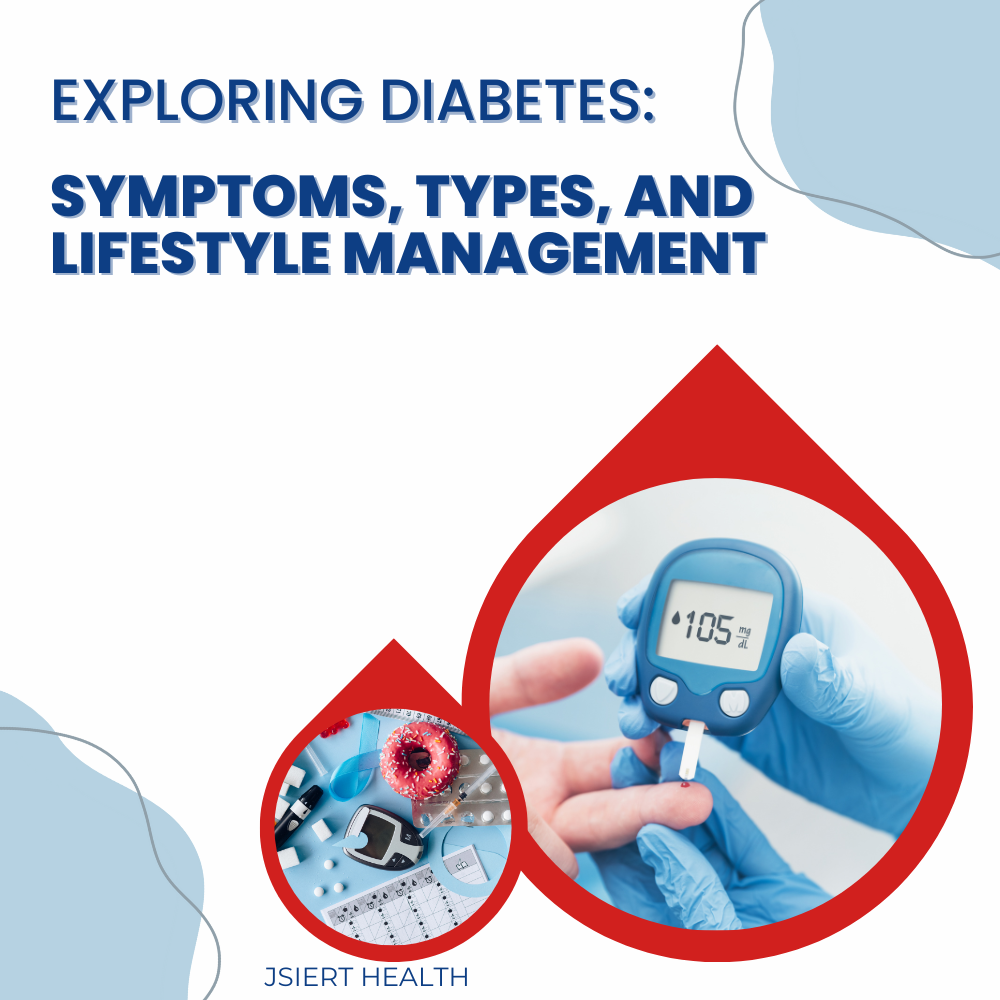
Introduction:
Diabetes is a chronic metabolic disorder characterized by elevated levels of glucose (sugar) in the blood, either due to insufficient insulin production, ineffective utilization of insulin, or a combination of both. It is a complex condition that requires ongoing management and can have significant impacts on individuals’ health and quality of life. In this introduction, we will provide an overview of diabetes, its historical background, prevalence and epidemiology, and the importance of raising awareness about this condition for effective symptom management, understanding its types, and adopting appropriate lifestyle management strategies.
A. Definition and Overview:
Diabetes mellitus, commonly referred to as diabetes, is a group of diseases that affect how the body regulates blood sugar. Insulin, a hormone produced by the pancreas, plays a crucial role in this process, helping cells absorb glucose from the bloodstream to use it as energy. In diabetes, the body either does not produce enough insulin (Type 1 diabetes), cannot effectively use the insulin it produces (Type 2 diabetes), or both.
B. Historical Background:
The history of diabetes dates back thousands of years, with early descriptions of the condition found in ancient medical texts. The term “diabetes” is derived from the Greek word meaning “siphon” or “to pass through,” referring to the excessive urination characteristic of the disease. In ancient times, diabetes was identified by its symptoms of frequent urination, increased thirst, and weight loss, but its underlying causes and treatments remained unknown.
It wasn’t until the 20th century that significant advancements were made in understanding and managing diabetes. The discovery of insulin in the 1920s revolutionized diabetes care, allowing individuals with Type 1 diabetes to live longer and healthier lives. Since then, research has continued to expand our knowledge of diabetes, leading to improvements in diagnostic techniques, treatment options, and prevention strategies.
C. Prevalence and Epidemiology:
Diabetes has reached epidemic proportions globally, with its prevalence steadily rising over the past few decades. According to the International Diabetes Federation (IDF), an estimated 463 million adults aged 20-79 years were living with diabetes worldwide in 2019, and this number is projected to rise to 700 million by 2045 if current trends persist. While Type 2 diabetes accounts for the majority of cases, Type 1 diabetes, gestational diabetes, and other forms of the condition also contribute to the overall disease burden.
The prevalence of diabetes varies by region, with higher rates observed in low- and middle-income countries, urban areas, and populations undergoing rapid socio-economic transitions. Factors such as aging populations, sedentary lifestyles, unhealthy diets, obesity, and genetic predisposition contribute to the increasing prevalence of diabetes worldwide.
D. Importance of Diabetes Awareness:
Raising awareness about diabetes is essential for several reasons. First and foremost, increased awareness helps individuals recognize the symptoms of diabetes early on, facilitating prompt diagnosis and treatment. Early intervention is crucial in preventing or delaying the onset of complications associated with diabetes, such as heart disease, stroke, kidney failure, vision loss, and nerve damage.
Furthermore, awareness initiatives play a vital role in dispelling myths and misconceptions surrounding diabetes, reducing stigma, and promoting understanding and empathy towards individuals living with the condition. By fostering a supportive and inclusive environment, we can empower those affected by diabetes to manage their health effectively and live fulfilling lives.
In the subsequent sections of this guide, we will delve deeper into the symptoms, types, and lifestyle management strategies for diabetes, providing readers with the knowledge and resources they need to navigate this complex condition with confidence and resilience. Together, let us work towards a world where diabetes awareness is widespread, and every individual affected by diabetes receives the support and care they deserve.
II. Understanding Diabetes:
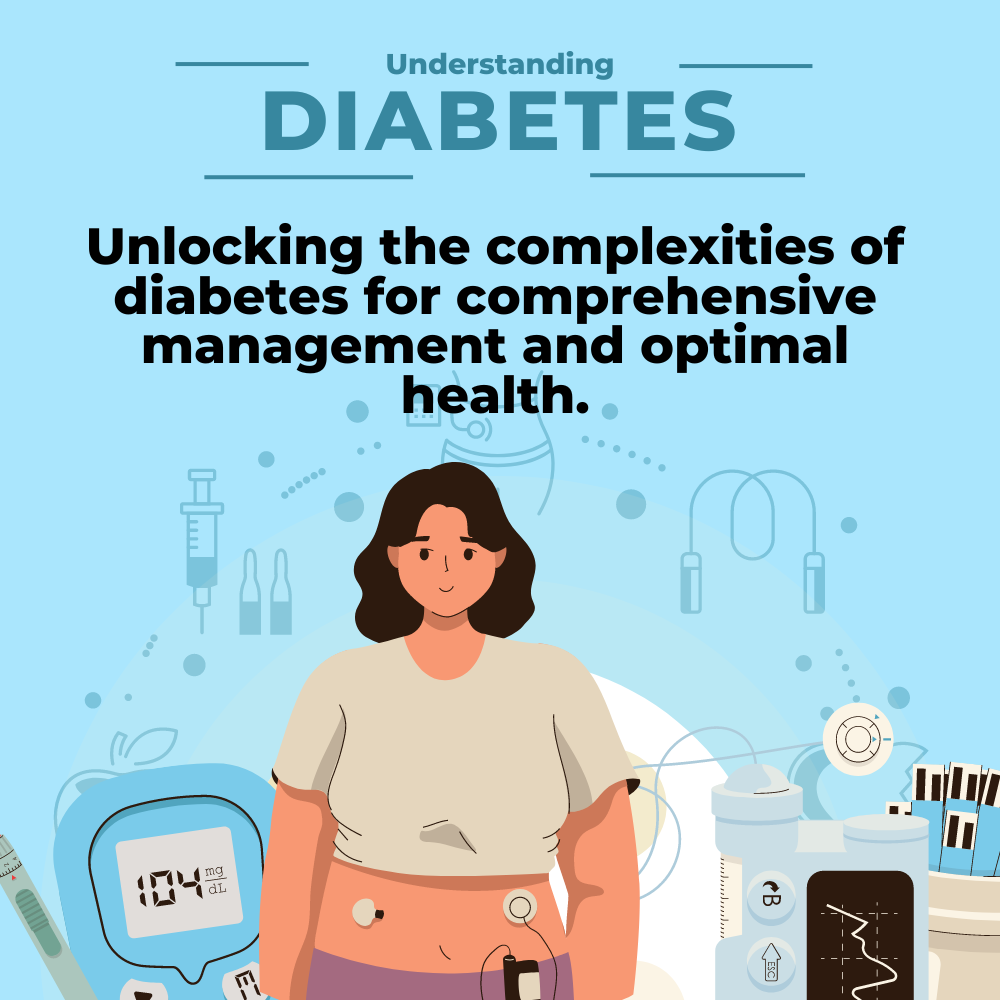
A. Physiology of Glucose Regulation: Diabetes disrupts the body’s intricate system for regulating blood glucose levels. Normally, when food is consumed, the digestive system breaks down carbohydrates into glucose, which enters the bloodstream. In response, the pancreas secretes insulin, a hormone that helps cells absorb glucose for energy or storage. When blood glucose levels rise, insulin facilitates its uptake into cells, thereby lowering blood sugar levels. Conversely, when blood glucose levels drop, the pancreas releases glucagon, prompting the liver to release stored glucose into the bloodstream to maintain balance. In diabetes, this delicate balance is disrupted, leading to either inadequate insulin production or impaired insulin function, resulting in persistently elevated blood sugar levels.
B. Role of Insulin: Insulin serves as a key regulator of glucose metabolism, facilitating the uptake of glucose into cells and promoting its conversion into energy or storage as glycogen and fat. Produced by beta cells in the pancreas, insulin binds to receptors on cell membranes, allowing glucose to enter cells from the bloodstream. Additionally, insulin inhibits the liver from releasing glucose into the bloodstream and enhances the uptake of glucose by muscle and adipose tissue. In diabetes, insulin production is deficient (Type 1) or ineffective (Type 2), leading to hyperglycemia and metabolic dysregulation.
C. Pathophysiology of Diabetes: The pathophysiology of diabetes varies depending on the type of diabetes and underlying mechanisms involved. In Type 1 diabetes, an autoimmune reaction leads to the destruction of insulin-producing beta cells in the pancreas, resulting in absolute insulin deficiency. This autoimmune process is triggered by genetic predisposition and environmental factors, such as viral infections or dietary factors. Type 2 diabetes is characterized by insulin resistance, where cells become less responsive to insulin’s actions, leading to elevated blood sugar levels. Over time, the pancreas may fail to compensate for insulin resistance, resulting in relative insulin deficiency. Other forms of diabetes, such as gestational diabetes and secondary diabetes, have distinct etiologies but share the common feature of dysregulated glucose metabolism.
D. Risk Factors and Genetic Predisposition: Diabetes is influenced by a complex interplay of genetic, environmental, and lifestyle factors. Individuals with a family history of diabetes are at higher risk of developing the condition, highlighting the role of genetic predisposition. Additionally, lifestyle factors such as sedentary behavior, unhealthy diet, obesity, and smoking contribute to the development of Type 2 diabetes. Gestational diabetes is associated with maternal obesity, advanced maternal age, and previous history of gestational diabetes. Understanding these risk factors is essential for early identification, prevention, and management of diabetes.
By comprehensively understanding the physiology, role of insulin, pathophysiology, and risk factors associated with diabetes, individuals can better grasp the mechanisms underlying this complex condition. This knowledge forms the foundation for effective management strategies aimed at controlling blood sugar levels, reducing complications, and improving overall health and well-being.
III. Types of Diabetes:
A. Type 1 Diabetes:
- Etiology and Pathogenesis:
- Type 1 diabetes is an autoimmune condition characterized by the destruction of insulin-producing beta cells in the pancreas.
- The exact cause is not fully understood, but genetic predisposition and environmental factors, such as viral infections, may trigger the autoimmune response.
- Clinical Presentation and Symptoms:
- Symptoms of Type 1 diabetes often develop rapidly and include excessive thirst, frequent urination, unexplained weight loss, fatigue, and blurred vision.
- Without insulin therapy, individuals with Type 1 diabetes may develop diabetic ketoacidosis (DKA), a life-threatening condition characterized by high blood sugar levels and ketone accumulation.
- Diagnosis and Screening:
- Diagnosis is typically based on blood tests measuring fasting blood glucose levels, random blood glucose levels, or hemoglobin A1c levels.
- Additional tests may include oral glucose tolerance tests and measurement of autoantibodies associated with Type 1 diabetes.
- Management and Treatment Approaches:
- Treatment involves lifelong insulin therapy to replace the deficient hormone and regulate blood sugar levels.
- Insulin may be administered through multiple daily injections or insulin pump therapy.
- Close monitoring of blood glucose levels, carbohydrate counting, and regular exercise are integral components of management.
- Complications and Long-term Effects:
- Untreated or poorly controlled Type 1 diabetes can lead to various complications, including cardiovascular disease, neuropathy, nephropathy, retinopathy, and foot ulcers.
- Long-term management aims to prevent complications through glycemic control, blood pressure management, lipid control, and regular screening for complications.
B. Type 2 Diabetes:
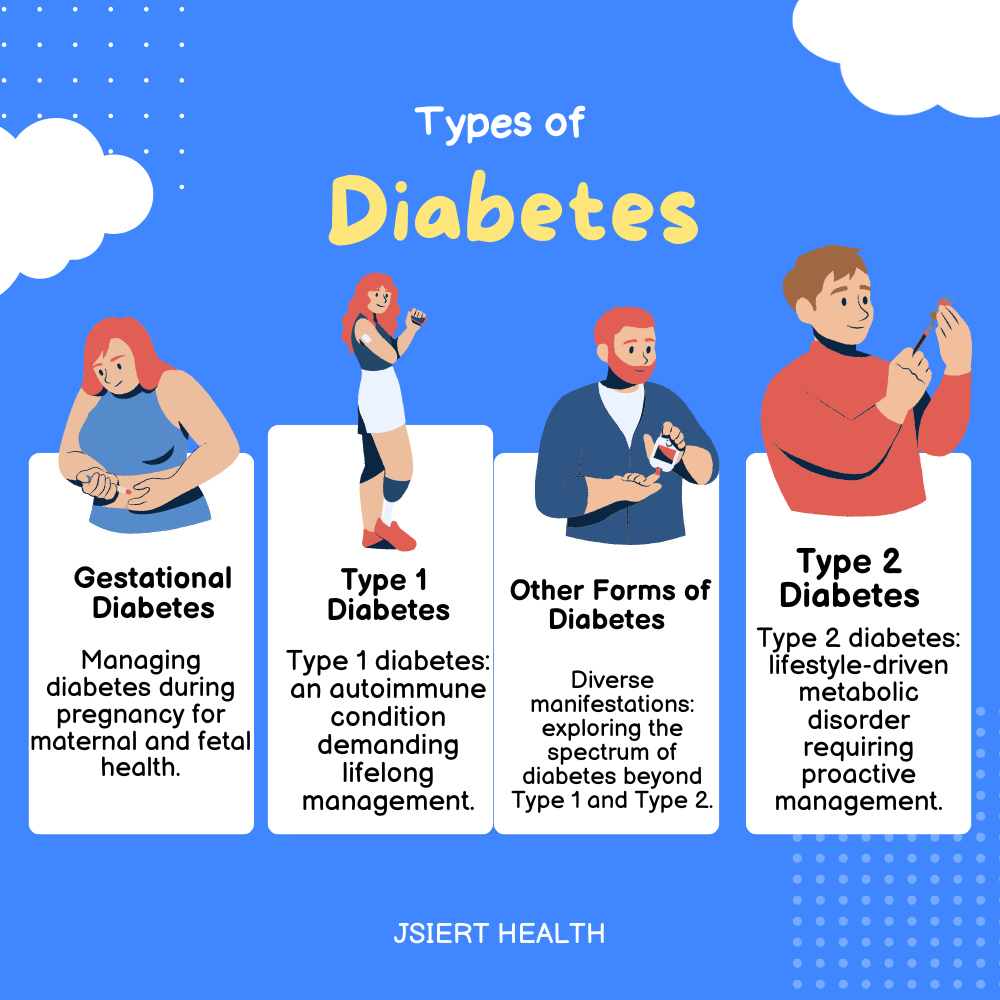
- Etiology and Risk Factors:
- Type 2 diabetes is characterized by insulin resistance and relative insulin deficiency.
- Risk factors include obesity, sedentary lifestyle, unhealthy diet, family history of diabetes, ethnicity, and advancing age.
- Symptoms and Diagnosis:
- Symptoms of Type 2 diabetes may develop gradually and include increased thirst, frequent urination, fatigue, blurred vision, slow wound healing, and recurrent infections.
- Diagnosis is typically made through blood tests measuring fasting blood glucose levels, oral glucose tolerance tests, or hemoglobin A1c levels.
- Lifestyle Management:
- Lifestyle interventions, including healthy eating, regular physical activity, weight loss, and smoking cessation, are fundamental for managing Type 2 diabetes.
- Dietary modifications may include portion control, carbohydrate counting, and choosing low-glycemic index foods.
- Pharmacological Treatment Options:
- Pharmacological therapy may be necessary to achieve glycemic targets in Type 2 diabetes.
- Oral antidiabetic medications, such as metformin, sulfonylureas, DPP-4 inhibitors, SGLT-2 inhibitors, and GLP-1 receptor agonists, are commonly prescribed.
- Insulin therapy may be initiated if oral medications are insufficient to control blood sugar levels.
- Complications and Comorbidities:
- Type 2 diabetes is associated with an increased risk of cardiovascular disease, stroke, neuropathy, nephropathy, retinopathy, and peripheral vascular disease.
- Management focuses on preventing complications through glycemic control, blood pressure management, lipid control, and lifestyle modifications.
C. Gestational Diabetes:
- Definition and Diagnosis:
- Gestational diabetes mellitus (GDM) is characterized by glucose intolerance that develops during pregnancy.
- Diagnosis is typically made through oral glucose tolerance tests performed between 24 and 28 weeks of gestation.
- Risk Factors and Screening:
- Risk factors for GDM include obesity, advanced maternal age, family history of diabetes, previous history of GDM, and certain ethnicities.
- Screening for GDM is recommended for all pregnant women, with additional testing for high-risk individuals.
- Management during Pregnancy:
- Management of GDM involves dietary modifications, regular physical activity, and blood glucose monitoring to maintain optimal glycemic control during pregnancy.
- Insulin therapy may be initiated if dietary and lifestyle interventions are insufficient to achieve glycemic targets.
- Postpartum Considerations:
- Women with a history of GDM are at increased risk of developing Type 2 diabetes later in life and should undergo postpartum screening for diabetes.
- Lifestyle modifications, including weight management and regular physical activity, are essential for reducing the risk of progression to Type 2 diabetes.
D. Other Forms of Diabetes:
- Monogenic Diabetes:
- Monogenic diabetes refers to a group of rare genetic disorders characterized by mutations in a single gene involved in pancreatic beta cell function or insulin action.
- Diagnosis is confirmed through genetic testing and may require specialized management approaches.
- Secondary Diabetes:
- Secondary diabetes results from other medical conditions or factors that affect insulin production or action, such as pancreatic diseases, certain medications, hormonal disorders, or genetic syndromes.
- Management involves addressing the underlying cause while managing blood sugar levels.
- Prediabetes and Impaired Glucose Tolerance:
- Prediabetes is a precursor to Type 2 diabetes, characterized by elevated blood sugar levels that are not high enough for a diabetes diagnosis.
- Lifestyle modifications, including weight loss, healthy eating, and regular physical activity, can prevent or delay the progression to Type 2 diabetes.
Understanding the various types of diabetes, their etiology, clinical presentation, diagnostic criteria, management approaches, and associated complications is crucial for effective management and prevention strategies. By addressing the unique characteristics and challenges of each type, individuals can optimize their health outcomes and reduce the burden of diabetes-related complications.
IV. Symptoms and Clinical Manifestations:
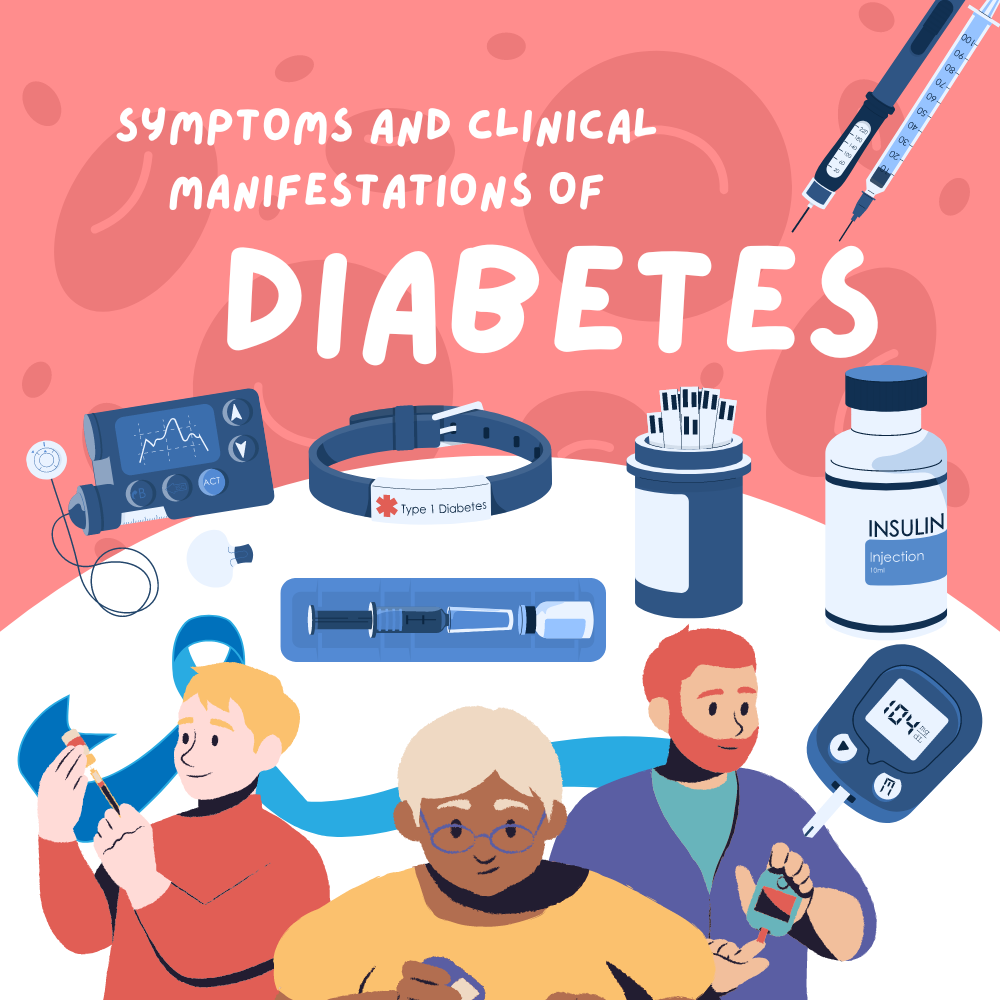
A. Common Symptoms of Diabetes:
- Polyuria: Excessive urination due to the kidneys’ attempt to eliminate excess glucose from the bloodstream.
- Polydipsia: Increased thirst resulting from dehydration caused by excessive urination.
- Polyphagia: Excessive hunger due to the body’s inability to properly utilize glucose for energy.
- Fatigue: Persistent tiredness or weakness, often despite adequate rest.
- Unexplained Weight Loss: Losing weight unintentionally, despite increased appetite and food intake.
- Blurred Vision: Vision problems, including blurry or distorted vision, caused by changes in fluid balance in the eyes.
- Slow Wound Healing: Cuts, bruises, or sores taking longer to heal than usual due to impaired circulation and immune response.
- Tingling or Numbness: Numbness, tingling, or pain in the hands, feet, or legs, indicative of nerve damage (neuropathy).
- Recurrent Infections: Increased susceptibility to infections, such as urinary tract infections, yeast infections, or skin infections.
- Dry Skin and Itching: Dry, itchy skin, often due to poor circulation and impaired wound healing.
B. Variations in Symptoms among Different Types:
- While some symptoms, such as polyuria, polydipsia, and unexplained weight loss, are common across all types of diabetes, there are variations in symptom presentation among different types:
- Type 1 Diabetes: Often presents with rapid onset of symptoms, including severe thirst, frequent urination, fatigue, and weight loss. Symptoms may develop abruptly, requiring immediate medical attention.
- Type 2 Diabetes: Symptoms may develop gradually and may be less pronounced initially. Patients may experience fatigue, blurred vision, slow wound healing, and recurrent infections. Many individuals with Type 2 diabetes may remain asymptomatic for an extended period, leading to delayed diagnosis.
- Gestational Diabetes: Symptoms may be similar to those of Type 2 diabetes but often manifest during pregnancy. Women may experience increased thirst, frequent urination, fatigue, and blurred vision. Gestational diabetes may resolve after childbirth but increases the risk of developing Type 2 diabetes later in life.
C. Complications of Uncontrolled Diabetes:
- Macrovascular Complications:
- Cardiovascular Disease: Increased risk of heart attack, stroke, and peripheral artery disease due to damage to blood vessels supplying the heart and other organs.
- Hypertension: High blood pressure, a common complication of diabetes, further increases the risk of cardiovascular events.
- Atherosclerosis: Build-up of plaque in the arteries, leading to reduced blood flow and increased risk of heart disease.
- Microvascular Complications:
- Diabetic Retinopathy: Damage to the blood vessels in the retina, leading to vision impairment and blindness if left untreated.
- Diabetic Nephropathy: Kidney damage resulting in proteinuria, hypertension, and eventually, end-stage renal disease.
- Diabetic Neuropathy: Nerve damage causing sensory, motor, or autonomic dysfunction, leading to pain, numbness, tingling, and impaired organ function.
- Neuropathic Complications:
- Peripheral Neuropathy: Damage to the peripheral nerves, causing pain, numbness, tingling, or weakness in the extremities.
- Autonomic Neuropathy: Dysfunction of the autonomic nervous system, leading to abnormalities in heart rate, blood pressure, digestion, and bladder function.
- Diabetic Foot Complications: Foot ulcers, infections, and peripheral vascular disease, resulting from nerve damage, poor circulation, and impaired wound healing.
Complications of uncontrolled diabetes can have serious consequences on overall health and quality of life. Early recognition of symptoms and prompt management are essential for preventing or minimizing complications and improving long-term outcomes for individuals with diabetes.
V. Diagnosis and Screening:
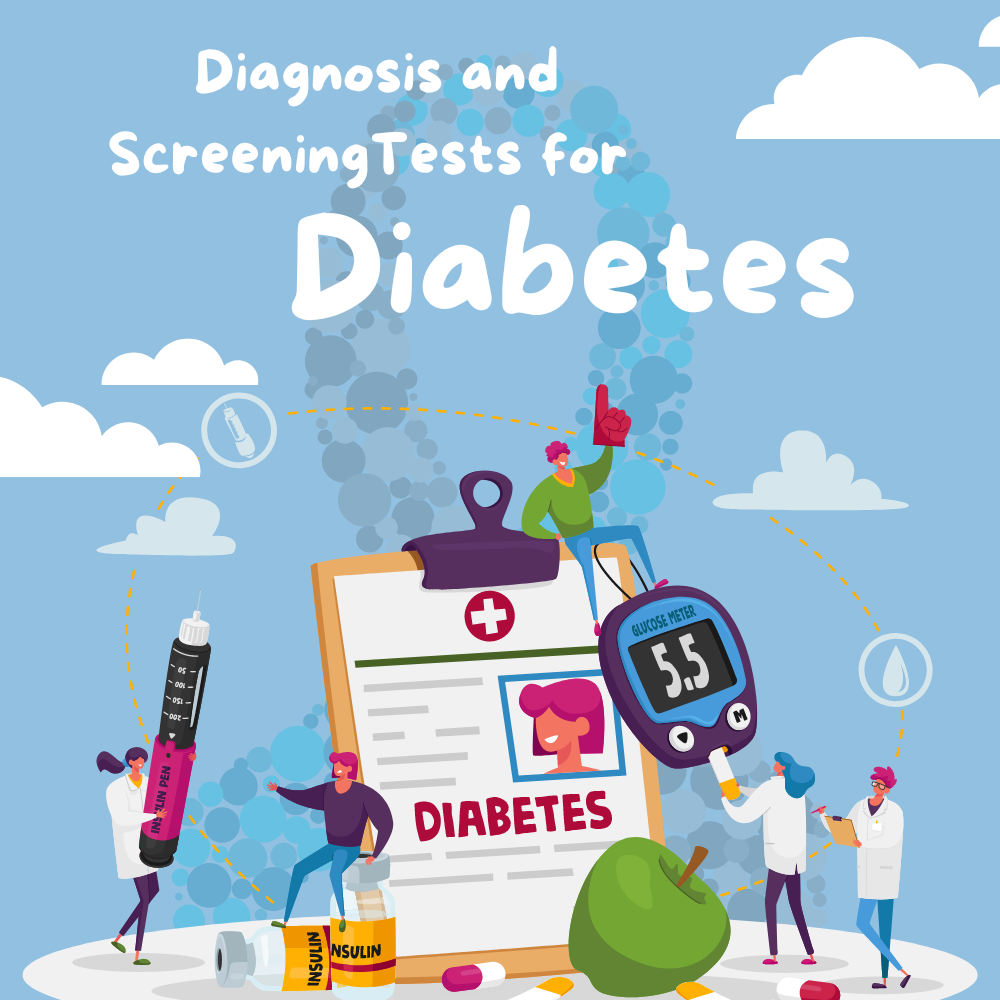
A. Laboratory Tests for Diabetes Diagnosis:
- Fasting Plasma Glucose (FPG) Test: Measures blood glucose levels after an overnight fast. A fasting plasma glucose level of 126 mg/dL (7.0 mmol/L) or higher on two separate occasions indicates diabetes.
- Oral Glucose Tolerance Test (OGTT): Involves drinking a glucose solution, followed by blood glucose measurements at intervals. A two-hour plasma glucose level of 200 mg/dL (11.1 mmol/L) or higher confirms diabetes.
- Hemoglobin A1c (HbA1c) Test: Provides an estimate of average blood glucose levels over the past 2-3 months. An HbA1c level of 6.5% or higher is indicative of diabetes.
- Random Plasma Glucose Test: Measures blood glucose levels at any time of the day, regardless of the last meal. A random plasma glucose level of 200 mg/dL (11.1 mmol/L) or higher with symptoms of hyperglycemia suggests diabetes.
B. Screening Guidelines and Recommendations:
- The American Diabetes Association (ADA) recommends screening for diabetes in asymptomatic individuals based on age, risk factors, and comorbidities.
- Adults aged 45 years and older should undergo diabetes screening every three years, especially if they are overweight or obese.
- Individuals with a body mass index (BMI) ≥25 kg/m² and one or more additional risk factors (e.g., family history of diabetes, physical inactivity, hypertension) should be screened for diabetes.
- Screening for gestational diabetes is recommended for all pregnant women between 24 and 28 weeks of gestation using an oral glucose tolerance test.
- High-risk individuals, such as those with prediabetes, polycystic ovary syndrome (PCOS), or a history of gestational diabetes, may require earlier or more frequent screening.
C. Importance of Early Detection and Intervention:
- Early detection of diabetes is crucial for initiating timely interventions to prevent or delay the onset of complications.
- Uncontrolled diabetes increases the risk of cardiovascular disease, neuropathy, nephropathy, retinopathy, and other serious complications.
- Early intervention through lifestyle modifications, medication therapy, and regular monitoring can help individuals achieve and maintain optimal blood glucose levels, reducing the risk of complications.
- Diabetes management also focuses on addressing modifiable risk factors, such as obesity, unhealthy diet, physical inactivity, and smoking, to improve overall health outcomes.
- Patient education and self-management skills play a vital role in empowering individuals with diabetes to make informed decisions about their health and adopt healthy lifestyle behaviors.
Timely diagnosis and proactive management of diabetes are essential for mitigating its adverse effects and improving long-term health outcomes. By adhering to screening guidelines, healthcare providers can identify individuals at risk of diabetes and initiate appropriate interventions to optimize their health and well-being.
VI. Treatment Approaches:
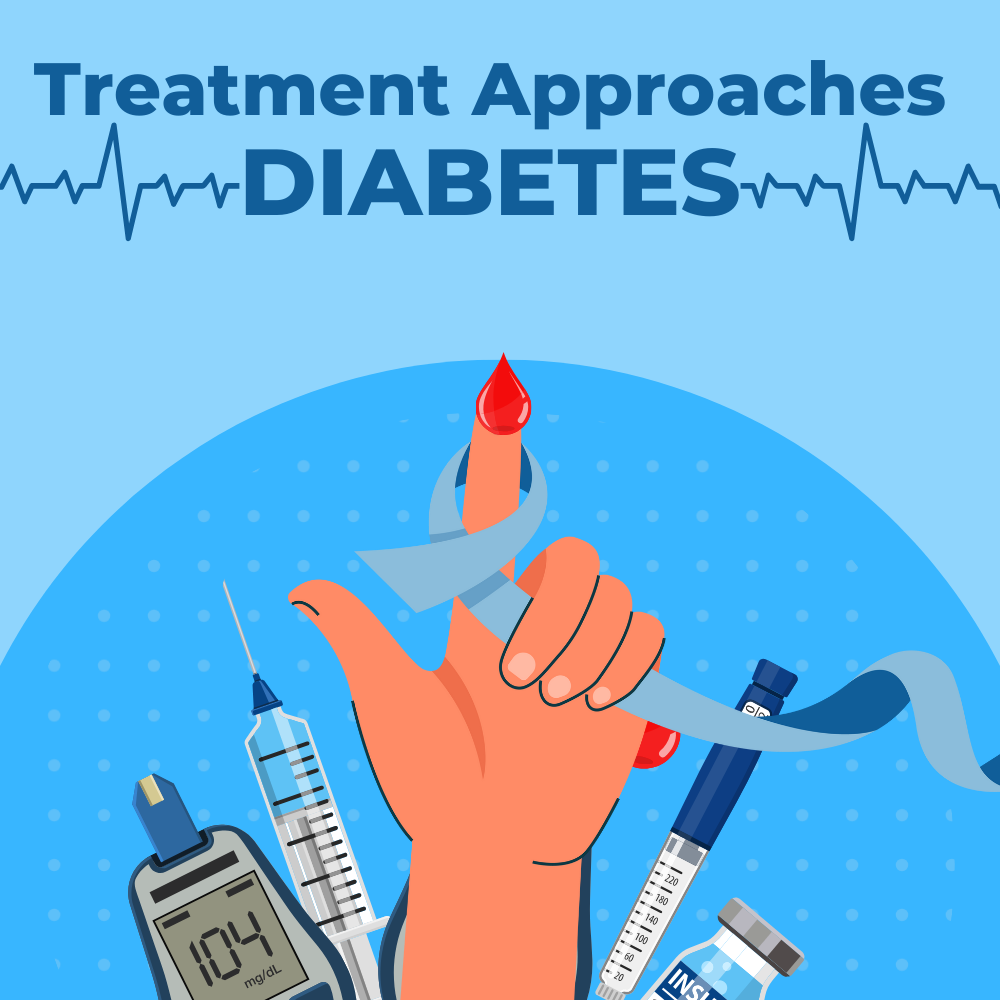
A. Lifestyle Modification:
- Diet and Nutrition Recommendations:
- Emphasize a balanced diet rich in fruits, vegetables, whole grains, lean proteins, and healthy fats.
- Limit intake of refined carbohydrates, sugary beverages, processed foods, and saturated fats.
- Monitor carbohydrate intake to manage blood glucose levels, and consider portion control and meal timing.
- Encourage regular meal patterns and spacing to prevent spikes and crashes in blood sugar levels.
- Exercise and Physical Activity Guidelines:
- Advocate for regular physical activity, including aerobic exercises, strength training, and flexibility exercises.
- Aim for at least 150 minutes of moderate-intensity aerobic activity or 75 minutes of vigorous-intensity activity per week.
- Incorporate physical activity into daily routines, such as walking, cycling, swimming, or participating in sports.
- Monitor blood glucose levels before and after exercise, and adjust medication dosages or carbohydrate intake as needed.
- Weight Management Strategies:
- Support weight loss efforts through a combination of diet, exercise, and behavioral modifications.
- Set realistic weight loss goals and track progress using methods such as food journals and regular weigh-ins.
- Offer support and encouragement to individuals struggling with weight management, and provide resources for healthy eating and active living.
B. Pharmacological Interventions:
- Insulin Therapy:
- Initiate insulin therapy for individuals with Type 1 diabetes or advanced Type 2 diabetes who are unable to achieve glycemic targets with lifestyle modifications and oral medications.
- Customize insulin regimens based on individual needs, including basal-bolus insulin therapy, premixed insulin formulations, and insulin pump therapy.
- Educate patients on proper insulin administration techniques, injection sites, and dosage adjustments according to blood glucose levels, carbohydrate intake, and physical activity.
- Oral Antidiabetic Medications:
- Prescribe oral antidiabetic medications, such as metformin, sulfonylureas, dipeptidyl peptidase-4 (DPP-4) inhibitors, sodium-glucose cotransporter-2 (SGLT2) inhibitors, and thiazolidinediones, based on individualized treatment goals, preferences, and contraindications.
- Monitor for potential side effects, including hypoglycemia, gastrointestinal disturbances, weight gain, and renal impairment, and adjust medications accordingly.
- Injectable Medications and GLP-1 Agonists:
- Consider injectable medications, such as glucagon-like peptide-1 (GLP-1) receptor agonists and amylin analogs, as adjunctive therapies for individuals with Type 2 diabetes who require additional glycemic control.
- Educate patients on proper injection techniques, dosing schedules, and potential side effects, including nausea, vomiting, and injection site reactions.
C. Emerging Therapies and Research Developments:
- Stay abreast of emerging therapies and research developments in diabetes management, including novel drug classes, insulin delivery systems, glucose monitoring technologies, and artificial pancreas systems.
- Participate in clinical trials and research studies to contribute to advancements in diabetes care and treatment options.
D. Role of Diabetes Education and Self-management:
- Provide comprehensive diabetes education and self-management support to empower individuals with the knowledge, skills, and confidence to manage their condition effectively.
- Offer structured diabetes education programs, individual counseling sessions, and ongoing support to address self-care behaviors, medication adherence, blood glucose monitoring, and lifestyle modifications.
- Collaborate with interdisciplinary healthcare teams, including nurses, dietitians, pharmacists, and educators, to deliver coordinated and personalized diabetes care plans tailored to each patient’s needs and preferences.
VII. Complications and Management:

A. Cardiovascular Complications:
- Coronary Artery Disease (CAD):
- CAD is a leading cause of morbidity and mortality in individuals with diabetes.
- Diabetes accelerates the progression of atherosclerosis, leading to the narrowing and hardening of coronary arteries.
- Management involves lifestyle modifications (e.g., healthy diet, regular exercise), blood pressure control, lipid-lowering therapy, antiplatelet agents, and revascularization procedures (e.g., angioplasty, coronary artery bypass grafting).
- Stroke and Cerebrovascular Disease:
- Diabetes increases the risk of stroke by promoting atherosclerosis, hypertension, and atrial fibrillation.
- Management focuses on controlling blood pressure, maintaining optimal blood glucose levels, and addressing modifiable risk factors (e.g., smoking, obesity).
- Rehabilitation and secondary prevention strategies, such as antiplatelet therapy and statin medications, are integral components of stroke management in individuals with diabetes.
- Peripheral Vascular Disease (PVD):
- PVD refers to the narrowing or blockage of blood vessels outside the heart and brain, primarily affecting the lower extremities.
- Diabetes accelerates the development of PVD through atherosclerosis and microvascular damage.
- Management includes lifestyle modifications (e.g., smoking cessation, regular exercise), blood glucose control, blood pressure management, and revascularization procedures (e.g., angioplasty, bypass surgery) for severe cases.
B. Renal Complications and Diabetic Nephropathy:
- Pathophysiology and Risk Factors:
- Diabetic nephropathy is a progressive kidney disease characterized by damage to the glomeruli and renal tubules.
- Risk factors include prolonged duration of diabetes, poor glycemic control, hypertension, and genetic predisposition.
- Pathophysiological mechanisms involve hyperglycemia-induced oxidative stress, inflammation, and activation of the renin-angiotensin-aldosterone system.
- Screening and Management Strategies:
- Screening for diabetic nephropathy involves regular monitoring of urinary albumin excretion and estimated glomerular filtration rate (eGFR).
- Management focuses on controlling blood pressure (target <130/80 mmHg), optimizing glycemic control, and renin-angiotensin-aldosterone system blockade (e.g., ACE inhibitors, ARBs).
- Lifestyle modifications, such as dietary sodium restriction and smoking cessation, are recommended to slow the progression of diabetic nephropathy.
- In advanced stages, renal replacement therapy (e.g., dialysis, kidney transplantation) may be necessary to manage end-stage renal disease.
C. Ocular Complications and Diabetic Retinopathy:
- Vision Changes and Eye Health:
- Diabetic retinopathy is a leading cause of blindness in adults, characterized by damage to the blood vessels in the retina.
- Symptoms include blurred vision, floaters, and eventually, vision loss if left untreated.
- Regular eye examinations, including dilated fundus exams and optical coherence tomography (OCT), are essential for early detection and intervention.
- Screening Guidelines and Treatment Options:
- Screening for diabetic retinopathy is recommended annually for individuals with Type 1 diabetes starting five years after diagnosis and at the time of diagnosis for Type 2 diabetes.
- Treatment options include laser photocoagulation, intravitreal injections (e.g., anti-VEGF agents), and vitrectomy surgery for advanced cases.
- Optimal glycemic control, blood pressure management, and lipid-lowering therapy are essential for preventing and managing diabetic retinopathy.
D. Neuropathic Complications:
- Peripheral Neuropathy:
- Peripheral neuropathy is a common complication of diabetes, characterized by nerve damage leading to sensory, motor, and autonomic dysfunction.
- Symptoms include numbness, tingling, burning pain, and loss of sensation in the extremities.
- Management involves glycemic control, pain management (e.g., medications, topical treatments), physical therapy, and lifestyle modifications.
- Autonomic Neuropathy:
- Autonomic neuropathy affects the autonomic nervous system, leading to dysfunction of organs and systems controlled by involuntary processes.
- Symptoms may include gastrointestinal disturbances, cardiovascular abnormalities (e.g., orthostatic hypotension, tachycardia), genitourinary dysfunction, and sudomotor dysfunction.
- Management focuses on symptomatic relief, blood pressure management, and lifestyle modifications.
- Foot Ulcers and Diabetic Neuropathic Pain:
- Diabetic neuropathy increases the risk of foot ulcers, infections, and diabetic neuropathic pain.
- Preventive measures include foot care education, regular foot inspections, proper footwear, and early intervention for foot problems.
- Management of diabetic neuropathic pain may involve medications (e.g., tricyclic antidepressants, anticonvulsants), topical treatments, physical therapy, and lifestyle modifications.
Effective management of diabetes-related complications requires a multidisciplinary approach, involving collaboration among healthcare providers, patients, and caregivers. By addressing cardiovascular, renal, ocular, and neuropathic complications proactively, individuals with diabetes can optimize their health outcomes and quality of life.
VIII. Prevention Strategies:
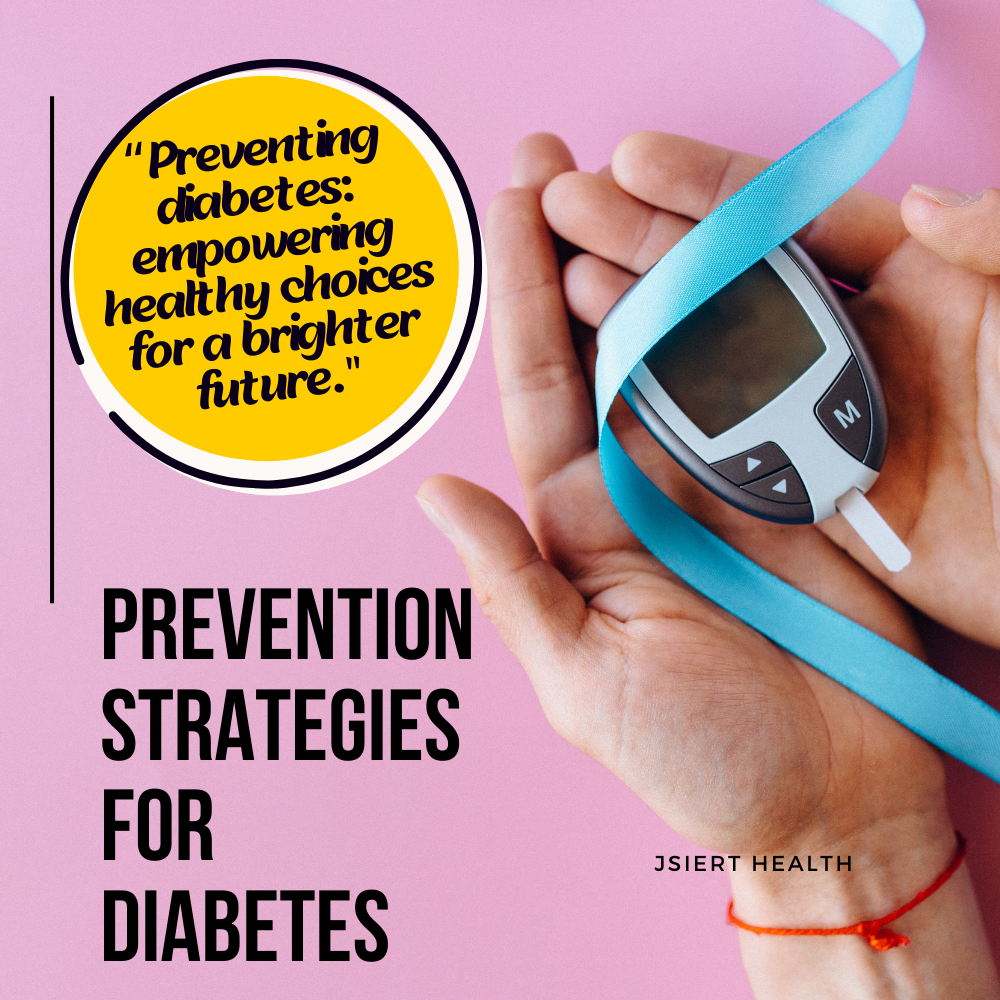
A. Primary Prevention Approaches:
- Promoting Healthy Eating Habits: Encourage the consumption of a balanced diet rich in fruits, vegetables, whole grains, lean proteins, and healthy fats. Limit intake of processed foods, sugary beverages, and high-calorie snacks.
- Encouraging Regular Physical Activity: Advocate for regular exercise and physical activity to maintain a healthy weight, improve insulin sensitivity, and lower the risk of developing diabetes. Aim for at least 150 minutes of moderate-intensity aerobic activity per week.
- Weight Management: Emphasize the importance of achieving and maintaining a healthy weight through a combination of diet, exercise, and lifestyle modifications. Even modest weight loss can significantly reduce the risk of developing Type 2 diabetes.
- Smoking Cessation: Promote smoking cessation programs and resources to reduce the risk of Type 2 diabetes, cardiovascular disease, and other complications associated with smoking.
- Stress Management: Encourage stress-reducing techniques such as mindfulness, meditation, yoga, and relaxation exercises to improve overall well-being and reduce the risk of diabetes.
- Education and Awareness: Provide education on diabetes risk factors, symptoms, and prevention strategies to empower individuals to make informed decisions about their health.
B. Public Health Initiatives and Awareness Campaigns:
- Community Outreach Programs: Collaborate with local health departments, community organizations, and schools to implement diabetes prevention programs, workshops, and educational seminars.
- Media Campaigns: Utilize various media platforms, including television, radio, social media, and print materials, to raise awareness about diabetes risk factors, prevention strategies, and available resources.
- Workplace Wellness Programs: Partner with employers to establish workplace wellness initiatives focused on promoting healthy lifestyle behaviors, including nutrition, physical activity, and stress management, to reduce the risk of diabetes among employees.
- Policy Advocacy: Advocate for policies and regulations that support healthy environments, such as access to affordable and nutritious foods, safe recreational spaces, and smoke-free environments.
C. Screening Programs and Early Detection Efforts:
- Community Screening Events: Organize free or low-cost diabetes screening events in collaboration with healthcare providers, community clinics, and local organizations to facilitate early detection and intervention.
- Targeted Screening Campaigns: Implement targeted screening efforts in high-risk populations, such as individuals with a family history of diabetes, overweight or obese individuals, and those from ethnic minority groups.
- Health Education and Counseling: Provide counseling and educational materials to individuals identified as at-risk for diabetes, emphasizing the importance of regular screenings, lifestyle modifications, and preventive measures.
- Integration with Primary Care: Integrate diabetes screening protocols into routine primary care visits, including assessments of risk factors, blood glucose monitoring, and referral to specialized services as needed.
D. Lifestyle Interventions for High-risk Individuals:
- Diabetes Prevention Programs: Offer evidence-based lifestyle intervention programs, such as the Diabetes Prevention Program (DPP), aimed at promoting weight loss, healthy eating, and increased physical activity to individuals at high risk of developing Type 2 diabetes.
- Nutritional Counseling: Provide personalized nutrition counseling and dietary guidance to individuals with prediabetes or other risk factors for diabetes to help them make healthier food choices and achieve weight loss goals.
- Exercise Prescription: Prescribe individualized exercise regimens tailored to the needs and preferences of high-risk individuals, including aerobic activities, strength training, and flexibility exercises, to improve fitness levels and metabolic health.
- Behavioral Support: Offer behavioral support, coaching, and motivational counseling to facilitate sustained behavior change and adherence to lifestyle modifications, addressing barriers and challenges along the way.
By implementing comprehensive prevention strategies that encompass primary prevention approaches, public health initiatives, screening programs, and lifestyle interventions, we can reduce the burden of diabetes and its associated complications, improve population health outcomes, and create healthier communities for all.
IX. Psychosocial Impact and Quality of Life:

A. Psychological Challenges of Living with Diabetes:
- Emotional Distress: Individuals with diabetes may experience heightened levels of anxiety, depression, stress, and fear related to managing their condition, coping with potential complications, and facing lifestyle changes.
- Diabetes Burnout: Long-term management of diabetes can be overwhelming, leading to feelings of frustration, exhaustion, and burnout. Coping with the demands of self-care, medication adherence, and blood glucose monitoring can contribute to emotional fatigue.
- Fear of Hypoglycemia: Fear of hypoglycemia (low blood sugar) can significantly impact the psychological well-being of individuals with diabetes, leading to hypoglycemia avoidance behaviors, anxiety, and impaired quality of life.
- Body Image Concerns: Diabetes-related complications, such as weight gain, insulin injections, and insulin pump therapy, may impact body image and self-esteem, leading to negative body image perceptions and disordered eating behaviors.
B. Coping Mechanisms and Support Systems:
- Social Support: Encourage individuals with diabetes to seek support from family members, friends, peers, and healthcare providers. Social support networks can provide emotional encouragement, practical assistance, and opportunities for shared experiences.
- Peer Support Groups: Facilitate peer support groups and online communities where individuals with diabetes can connect with others facing similar challenges, share coping strategies, and exchange information and advice.
- Cognitive Behavioral Therapy (CBT): Offer CBT interventions tailored to address diabetes-specific stressors, negative thought patterns, and maladaptive coping behaviors. CBT can help individuals develop adaptive coping skills, enhance problem-solving abilities, and improve emotional resilience.
- Diabetes Education and Self-Management Programs: Provide comprehensive diabetes education and self-management programs that incorporate psychosocial support components, stress management techniques, and coping skills training.
C. Addressing Stigma and Discrimination:
- Educating the Public: Raise awareness about diabetes and combat misconceptions, stereotypes, and stigma surrounding the condition. Promote understanding and empathy by emphasizing the biological nature of diabetes and dispelling myths about its causes and consequences.
- Advocating for Inclusion: Advocate for policies and practices that promote inclusivity, accessibility, and equal opportunities for individuals with diabetes in various settings, including schools, workplaces, healthcare facilities, and public spaces.
- Empowering Individuals: Empower individuals with diabetes to advocate for their rights, challenge discrimination, and assert their needs and preferences. Provide resources and support to help individuals navigate legal, social, and institutional barriers.
D. Improving Quality of Life for Individuals with Diabetes:
- Holistic Care Approach: Adopt a holistic approach to diabetes care that addresses not only medical needs but also psychosocial, emotional, and lifestyle factors impacting quality of life.
- Patient-Centered Care: Involve individuals with diabetes in treatment decision-making, goal setting, and care planning to ensure their preferences, values, and priorities are respected and incorporated into their care plans.
- Enhancing Self-Efficacy: Foster self-efficacy and empowerment by providing education, resources, and skills training to help individuals with diabetes feel confident and competent in managing their condition and making informed decisions.
- Continuous Monitoring and Support: Offer ongoing monitoring, follow-up, and support to individuals with diabetes to assess their psychosocial well-being, address emerging challenges, and provide timely interventions as needed.
By recognizing and addressing the psychosocial impact of diabetes, promoting coping mechanisms and support systems, combating stigma and discrimination, and prioritizing strategies to improve quality of life, we can enhance the overall well-being and resilience of individuals living with diabetes. Integrating psychosocial support into diabetes care can lead to better outcomes, increased treatment adherence, and a higher quality of life for individuals with diabetes.
X. Future Directions and Research:
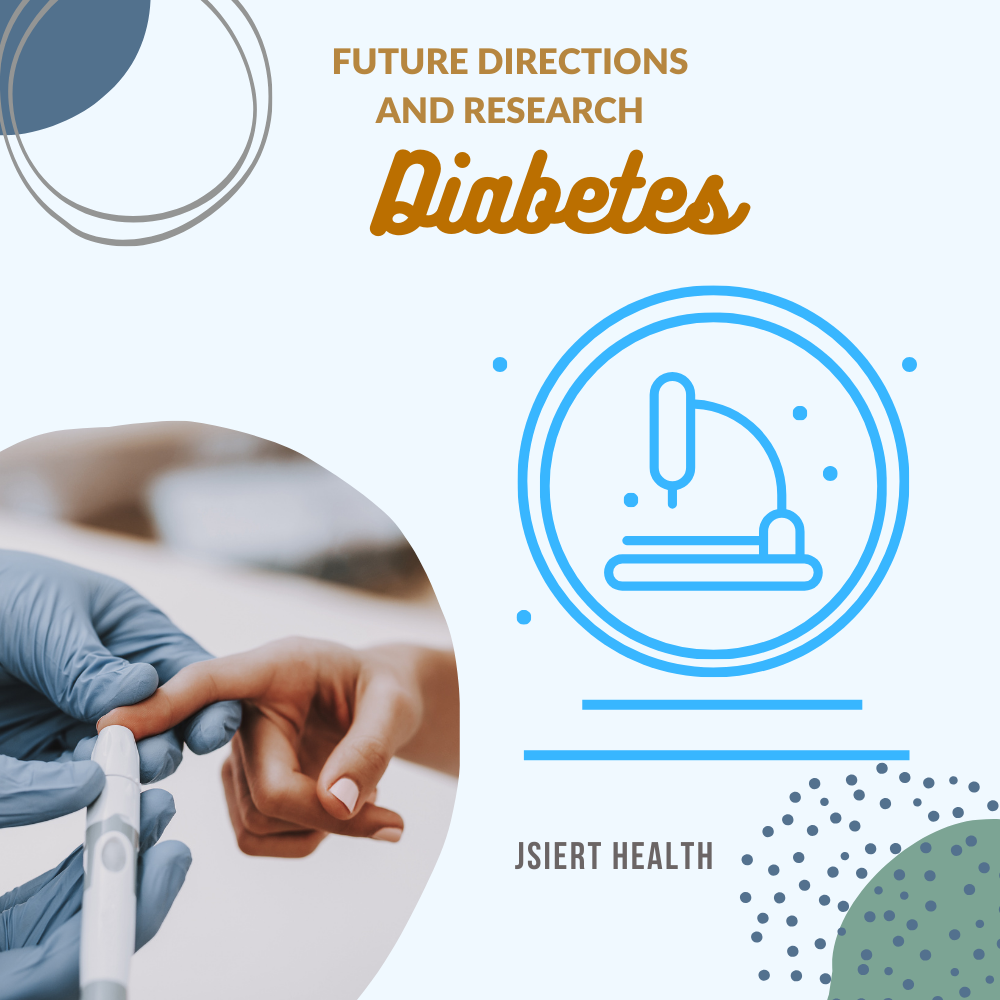
A. Advances in Diabetes Management and Technology:
- Continuous Glucose Monitoring (CGM): Continued advancements in CGM technology, including improved accuracy, reliability, and integration with insulin delivery systems, offer greater convenience and precision in glucose monitoring for individuals with diabetes.
- Closed-Loop Systems: Development of closed-loop insulin delivery systems, also known as artificial pancreas systems, holds promise for optimizing glucose control and reducing the burden of diabetes self-management by automating insulin dosing based on real-time glucose readings.
- Personalized Medicine: Utilization of personalized approaches, such as genetic profiling, biomarker analysis, and digital health tools, enables tailored diabetes management strategies based on individual characteristics, preferences, and responses to treatment.
- Telemedicine and Remote Monitoring: Expansion of telemedicine platforms and remote monitoring technologies facilitates remote consultations, real-time data sharing, and virtual care delivery, enhancing access to diabetes care and improving patient-provider communication and engagement.
B. Promising Areas of Research and Innovation:
- Beta Cell Regeneration: Investigating novel therapies and regenerative medicine approaches aimed at restoring beta cell function and promoting beta cell regeneration offers potential for curing or reversing Type 1 diabetes.
- Immunotherapy: Advancements in immunotherapy, including antigen-specific immunomodulation and immune tolerance induction, hold promise for preventing or halting the autoimmune destruction of beta cells in Type 1 diabetes.
- Precision Medicine: Harnessing precision medicine approaches, such as pharmacogenomics and targeted therapies, enables personalized treatment strategies tailored to the unique genetic, molecular, and metabolic profiles of individuals with diabetes.
- Novel Drug Targets: Identification of novel drug targets, such as inflammatory pathways, mitochondrial function, and epigenetic modifiers, presents opportunities for developing innovative pharmacological interventions for diabetes management and complications prevention.
C. Challenges and Opportunities in Diabetes Care:
- Access to Care: Addressing disparities in access to diabetes care, including healthcare access, affordability, and healthcare delivery models, remains a significant challenge, particularly among underserved and marginalized populations.
- Multimorbidity Management: Managing diabetes in the context of multimorbidity, including comorbidities such as cardiovascular disease, hypertension, obesity, and mental health disorders, poses complex clinical challenges and requires integrated, patient-centered care approaches.
- Behavioral Change: Promoting sustained behavioral change and adherence to lifestyle modifications, medication regimens, and self-care practices remains a critical challenge in diabetes management, necessitating tailored, culturally sensitive interventions and ongoing support.
- Disease Prevention: Scaling up preventive strategies, including population-level interventions, public health initiatives, and policy reforms, is essential for reducing the incidence and prevalence of diabetes and its associated complications, addressing the growing global burden of the disease.
By advancing research and innovation in diabetes management and technology, identifying promising areas of research, and addressing challenges and opportunities in diabetes care, we can improve outcomes for individuals with diabetes, enhance quality of life, and mitigate the societal and economic impact of this chronic condition. Collaboration among stakeholders, investment in research and development, and commitment to patient-centered care are essential for shaping the future of diabetes care and management.
XI. Conclusion:
A. Summary of Key Points:
- Diabetes is a complex metabolic disorder characterized by impaired glucose regulation, leading to hyperglycemia and associated complications.
- Understanding the various types of diabetes, including Type 1, Type 2, gestational diabetes, and other forms, is essential for effective management and prevention strategies.
- Early diagnosis and intervention are crucial for preventing complications and improving long-term health outcomes for individuals with diabetes.
- Comprehensive diabetes care involves a multidisciplinary approach, addressing medical, psychosocial, and lifestyle factors to optimize quality of life and well-being.
B. Importance of Multidisciplinary Care:
- Multidisciplinary care involves collaboration among healthcare professionals, including physicians, nurses, dietitians, psychologists, and educators, to provide holistic and patient-centered diabetes management.
- By addressing the diverse needs and challenges of individuals with diabetes through a multidisciplinary approach, we can enhance treatment outcomes, improve self-management skills, and promote overall health and wellness.
C. Call to Action for Diabetes Prevention and Management:
- Diabetes prevention efforts should focus on promoting healthy lifestyle behaviors, including balanced nutrition, regular physical activity, weight management, and smoking cessation.
- Public health initiatives, community outreach programs, and policy advocacy are essential for raising awareness, increasing access to care, and reducing disparities in diabetes prevention and management.
- Empowering individuals with diabetes through education, support, and self-management skills can help them make informed decisions, adhere to treatment plans, and achieve optimal health outcomes.
D. Hope for the Future: Towards a World without Diabetes:
- Despite the challenges posed by diabetes, ongoing research, technological advancements, and innovative therapies offer hope for the future.
- Promising areas of research include the development of novel treatments, precision medicine approaches, artificial intelligence applications, and advanced glucose monitoring technologies.
- With continued efforts in prevention, early detection, and comprehensive care, we can envision a future where diabetes incidence is reduced, complications are minimized, and individuals with diabetes can lead healthy and fulfilling lives.
In conclusion, addressing the complexities of diabetes requires a multifaceted approach that encompasses prevention, early detection, multidisciplinary care, and ongoing research and innovation. By working together to raise awareness, promote healthy behaviors, and advance diabetes care and management, we can strive towards a world where diabetes no longer poses a significant threat to global health and well-being.
FAQ for Exploring Diabetes: Symptoms, Types, and Lifestyle Management
- What are the common symptoms of diabetes?
- Common symptoms of diabetes include excessive thirst (polydipsia), frequent urination (polyuria), increased hunger (polyphagia), unexplained weight loss, fatigue, blurred vision, slow wound healing, and tingling or numbness in the extremities.
- What are the different types of diabetes?
- There are several types of diabetes, including Type 1 diabetes, Type 2 diabetes, gestational diabetes, monogenic diabetes, and secondary diabetes. Each type has distinct causes, risk factors, and management approaches.
- What are the risk factors for developing diabetes?
- Risk factors for diabetes include family history, obesity, sedentary lifestyle, poor diet, age, ethnicity, gestational diabetes during pregnancy, polycystic ovary syndrome (PCOS), and certain medical conditions or medications.
- How is diabetes diagnosed?
- Diabetes is diagnosed through laboratory tests, including fasting plasma glucose (FPG) test, oral glucose tolerance test (OGTT), hemoglobin A1c (HbA1c) test, and random plasma glucose test. Screening guidelines recommend testing based on age, risk factors, and symptoms.
- What are the complications of uncontrolled diabetes?
- Uncontrolled diabetes can lead to various complications, including cardiovascular disease, neuropathy, nephropathy, retinopathy, foot ulcers, and diabetic ketoacidosis (DKA). These complications can have serious consequences on overall health and quality of life.
- How can diabetes be managed?
- Diabetes management involves lifestyle modifications, including healthy eating, regular exercise, weight management, blood glucose monitoring, medication therapy (insulin or oral medications), and regular medical check-ups. Individualized treatment plans are tailored to each person’s needs.
- What lifestyle changes can help prevent or manage diabetes?
- Lifestyle changes such as adopting a healthy diet, engaging in regular physical activity, maintaining a healthy weight, quitting smoking, managing stress, and monitoring blood glucose levels can help prevent or manage diabetes effectively.
- Is diabetes preventable?
- While some risk factors for diabetes cannot be controlled, such as family history and age, adopting a healthy lifestyle can significantly reduce the risk of developing Type 2 diabetes. Preventive measures include maintaining a healthy weight, being physically active, and eating a balanced diet.
- How can I support a loved one with diabetes?
- You can support a loved one with diabetes by offering encouragement, helping them adhere to their treatment plan, participating in healthy activities together, educating yourself about diabetes, and providing emotional support.
- Where can I find more information about diabetes?
- You can find more information about diabetes from reputable sources such as healthcare providers, diabetes organizations (e.g., American Diabetes Association, International Diabetes Federation), government health websites, and educational resources on diabetes management and prevention.